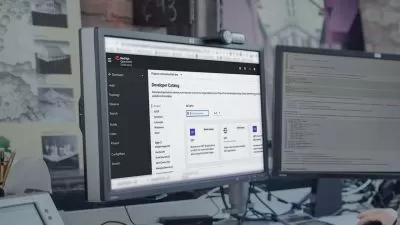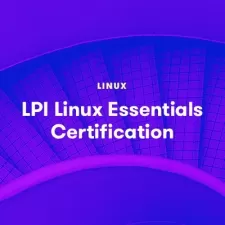LPI Linux Essentials Certification Course and Practice Exams
Jason Cannon
8:25:14
Description
Comprehensive Linux training with study guide and practice tests for the LPI Linux Essentials certification (010-160)
What You'll Learn?
- Certification Success: Equip yourself with knowledge and strategies to confidently pass the LPI Linux Essentials Certification exam.
- Linux Fundamentals: Explore the history of Linux, learn about major open-source applications, and understand software licensing models such as GPL and MIT.
- Software Installation: Learn how to easily install, update, and manage software packages on Debian/Ubuntu and RedHat/Fedora systems.
- Navigate and Manage Files: Get comfortable navigating the Linux file system and managing files and directories with essential command-line commands.
- User and Group Management: Learn to set up Linux users and groups, including creating accounts, setting permissions, and configuring security settings.
- Command-Line Proficiency: Harness command-line tools to search, extract data, and automate tasks through scripting.
- Basic Networking and Security: Build a solid foundation in Linux networking concepts, hardware components, and system security practices.
Who is this for?
What You Need to Know?
More details
DescriptionPass the LPI Linux Essentials Exam and Fast-Track Your IT Career!
Unlock the door to a thriving IT career with this all-inclusive LPI Linux Essentials Certification Course. Designed for complete beginners, this course provides a solid foundation in Linux, preparing you to ace the LPI Linux Essentials Certification exam (010-160) on your first attempt.
Why Take This Course?
Certification Success: Equip yourself with the knowledge and strategies to confidently pass the LPI Linux Essentials Certification exam.
Hands-On Learning: Dive deep into Linux fundamentals with practical demonstrations on Debian/Ubuntu and RedHat/Fedora systems.
Comprehensive Coverage: From understanding open-source software and licensing to mastering the command line, we've got you covered.
Expert Instruction: Learn from an industry professional with decades of experience in Linux and open-source technologies.
Career Advancement: Validate your skills and stand out in the competitive IT job market.
What You'll Learn:
Linux Fundamentals: Explore the history of Linux and its role in today's technology landscape.
Software Installation: Master package management and software installation across different Linux distributions.
File Management: Navigate the Linux file system and efficiently manage files and directories.
User and Group Management: Set up and manage users, groups, and permissions to secure your system.
Command-Line Proficiency: Harness powerful command-line tools to automate tasks and enhance productivity.
Networking and Security: Build a solid foundation in networking concepts and learn essential security practices.
Who Should Enroll?
Aspiring IT Professionals: Kickstart your career by gaining essential Linux skills.
Certification Seekers: Anyone aiming to obtain the LPI Linux Essentials Certification.
Complete Beginners: No prior Linux experience needed—we start from the ground up.
Career Changers: Transition into tech roles with confidence and validated skills.
Tech Enthusiasts: Deepen your understanding of Linux and open-source applications.
Take the Next Step
Linux skills are in high demand. Whether you're starting your IT journey or looking to validate your expertise, this course is your gateway to success.
Enroll Now and Become a Certified Linux Professional!
Who this course is for:
- Anyone looking to obtain the LPI Linux Essentials Certification.
- Aspiring IT Professionals: Individuals wanting to start a career in IT and looking to validate their Linux knowledge with the LPI Linux Essentials Certification.
- Complete Linux Beginners: People with little to no prior experience with Linux who want a structured, step-by-step guide to understanding Linux fundamentals.
- Career Changers: Individuals from non-technical backgrounds aiming to gain essential Linux skills to transition into technology roles.
Pass the LPI Linux Essentials Exam and Fast-Track Your IT Career!
Unlock the door to a thriving IT career with this all-inclusive LPI Linux Essentials Certification Course. Designed for complete beginners, this course provides a solid foundation in Linux, preparing you to ace the LPI Linux Essentials Certification exam (010-160) on your first attempt.
Why Take This Course?
Certification Success: Equip yourself with the knowledge and strategies to confidently pass the LPI Linux Essentials Certification exam.
Hands-On Learning: Dive deep into Linux fundamentals with practical demonstrations on Debian/Ubuntu and RedHat/Fedora systems.
Comprehensive Coverage: From understanding open-source software and licensing to mastering the command line, we've got you covered.
Expert Instruction: Learn from an industry professional with decades of experience in Linux and open-source technologies.
Career Advancement: Validate your skills and stand out in the competitive IT job market.
What You'll Learn:
Linux Fundamentals: Explore the history of Linux and its role in today's technology landscape.
Software Installation: Master package management and software installation across different Linux distributions.
File Management: Navigate the Linux file system and efficiently manage files and directories.
User and Group Management: Set up and manage users, groups, and permissions to secure your system.
Command-Line Proficiency: Harness powerful command-line tools to automate tasks and enhance productivity.
Networking and Security: Build a solid foundation in networking concepts and learn essential security practices.
Who Should Enroll?
Aspiring IT Professionals: Kickstart your career by gaining essential Linux skills.
Certification Seekers: Anyone aiming to obtain the LPI Linux Essentials Certification.
Complete Beginners: No prior Linux experience needed—we start from the ground up.
Career Changers: Transition into tech roles with confidence and validated skills.
Tech Enthusiasts: Deepen your understanding of Linux and open-source applications.
Take the Next Step
Linux skills are in high demand. Whether you're starting your IT journey or looking to validate your expertise, this course is your gateway to success.
Enroll Now and Become a Certified Linux Professional!
Who this course is for:
- Anyone looking to obtain the LPI Linux Essentials Certification.
- Aspiring IT Professionals: Individuals wanting to start a career in IT and looking to validate their Linux knowledge with the LPI Linux Essentials Certification.
- Complete Linux Beginners: People with little to no prior experience with Linux who want a structured, step-by-step guide to understanding Linux fundamentals.
- Career Changers: Individuals from non-technical backgrounds aiming to gain essential Linux skills to transition into technology roles.
User Reviews
Rating
Jason Cannon
Instructor's Courses
Udemy
View courses Udemy- language english
- Training sessions 135
- duration 8:25:14
- Release Date 2024/12/21










